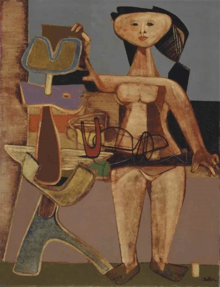Jankel Adler
Jankel Adler (born Jankiel Jakub Adler;[1] 26 July 1895 – 25 April 1949) was a Polish painter and printmaker.
Jankel Adler | |
|---|---|
.jpg) Adler in 1924, photographed by August Sander | |
| Born | Jankiel Jakub Adler July 26, 1895 |
| Died | April 25, 1949 (aged 53) |
| Nationality | Polish |
| Education | Barmen School of Art |
| Known for | Painting, printmaking |
Biography
Jankiel Jakub Adler was born as the seventh of ten children in Tuszyn, a suburb of Łódź. In 1912 he began training as an engraver with his uncle in Belgrade. He moved in 1914 to Germany where he lived for a time with his sister in Barmen, (now part of Wuppertal). There he studied at the college of arts and crafts with professor Gustav Wiethücher.
From 1918 to 1919 he went back to Łódź, where he was joint founder of "Jung Jidysz", a group of avant-garde artists. In 1920 he returned briefly to Berlin; in 1921 he returned to Barmen, and in 1922 he moved to Düsseldorf.
In May 1922 he attended the International Congress of Progressive Artists and signed the "Founding Proclamation of the Union of Progressive International Artists".[2]
He also joined Franz Seiwert and Otto Freundlich in an artists group known as the Cologne Progressives.[3] He became a teacher at the Academy of Arts, and became acquainted with Paul Klee, who influenced his work. A painting by Adler received a gold medal at the exhibition "German art Düsseldorf" in 1928.
In 1929 and 1930 he went on study trips in Mallorca and other places in Spain. During the election campaign of July 1932 he published with a group of leftist artists and intellectuals an urgent appeal against the policy of the National Socialists and for communism. As a modern artist, and especially as a Jew, he faced persecution under Hitler's regime which took power in 1933. In that year, two of his pictures were displayed by the Nazis at the Mannheimer Arts Center as examples of degenerate art, and Adler left Germany, staying in Paris where he regarded his exile consciously as political resistance against the fascist regime in Germany. In the years that followed, he made numerous journeys to Poland, Italy, Yugoslavia, Czechoslovakia, Romania and the Soviet Union. He also spent time in Paris, working at Atelier 17.[4] In 1937, twenty-five of his works were seized from public collections by the Nazis and four were shown in the Entartete Kunst (Degenerate Art) exhibition in Munich.

With the outbreak of World War II in 1939, he volunteered for the Polish army that had been reconstituted in France; in 1941 he was discharged for health reasons and lived thereafter in Kirkcudbright in Scotland where his work at this time include his Venus of Kirkcudbright.[5] In 1943 he moved to London. Died in Whitley Cottage in Aldbourne,[6] Wiltshire on 25 April 1949 at the age of 53 years and with the bitter knowledge that none of his nine brothers and sisters had survived the Holocaust.
Work

Adler was strongly influenced by Picasso and Léger. He enjoyed experimenting with materials, for example sand admixtures. He often painted Jewish subjects, and painted some few abstract compositions.
See also
Bibliography
- Stefan Themerson, Jankel Adler: an artist seen from one of many possible angles, Gaberbocchus Press, London. 1948
- Andrzej Kempa, Marek Szukalak, The Biographical Dictionary of the Jews from Lodz, Łódź 2006: Oficyna Bibliofilów and Fundacja Monumentum Iudaicum Lodzense, pp. 6–7, ISBN 83-87522-83-X.
- Annemarie Heibel, Jankel Adler (1895-1949). Band I: Monografie, Band II: Werkverzeichnis der Gemälde (= Wissenschaftliche Schriften der WWU Münster, Reihe X. Band 23). Verlagshaus Monsenstein und Vannerdat OHG, Münster 2016, ISBN 978-3-8405-0128-9. Online edition: http://nbn-resolving.de/urn:nbn:de:hbz:6-88239662183.
References
- Dudzik, Wojciech (2011). Theater-Bewusstsein: Polnisches Theater in der zweiten Hälfte des 20. Jahrhunderts : Ideen, Konzepte, Manifeste (in German). LIT Verlag Münster. p. 121. ISBN 9783643111708. Retrieved 1 July 2019.
- van Doesburg, Theo. "De Stijl, "A Short Review of the Proceedings [of the Congress of International Progressive Artists], Followed by the Statements Made by the Artists' Groups" (1922)". modernistarchitecture.wordpress.com. Ross Lawrence Wolfe. Retrieved 30 November 2018.
- Benus, Benjamin. "Figurative Constructivism, Pictorial Statistics, and the Group of Progressive Artists, c. 1920-1939" (PDF). DRUM. University of Maryland. Retrieved 6 February 2018.
- "Adler, Jankel, 1895–1949". Art UK. Retrieved 20 February 2020.
- "Kirkcudbright Galleries". June 2019. Retrieved 28 June 2019.
- Lee, David; Shuttleworth, Malcolm, eds. (2000). The Millennium Book of Aldbourne - A Snapshot of the Parish in the Year 2000. Aldbourne: Trustees of the Aldbourne Memorial Hall. p. 201.
External links
| Wikimedia Commons has media related to Jankel Adler. |
- Jankel Adler collection at the Israel Museum. Retrieved September 2016.